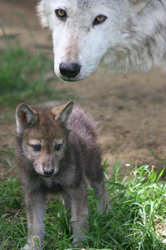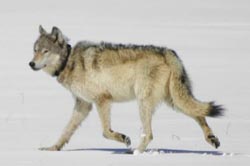Gray Wolves
Updated: August 12, 2020

Not all gray wolves are gray! Gray wolves can range in color from white to black, although gray is the most common color. About half the wolves in Montana are black with the other half gray. Both color phases may be found in a pack or in a litter of pups. The gray wolf is the largest of the wild dogs. They are larger than coyotes and red wolves. Male gray wolves may be over five to six feet long and weigh up to 100 pounds; females are 70 to 80 pounds.
Wolf groups or packs usually consist of a set of parents (alpha pair), their offspring and other non-breeding adults. Each pack has an average of six to ten wolves. The leaders of the pack are the dominant pair known as the alpha male and alpha female.
The alpha female is the only female in the pack to have pups. When it is nearly time for the pups to be born, the alpha female digs a den. Pups are usually born in April or May. When they are born, they cannot hear or see. Eventually, their eyes open when they are about two weeks old, and hearing develops at the age of three weeks.

When pups are about eight weeks old, their mother takes them to live with the pack. The other members of the pack help to raise pups too. In the fall, when pups are older, they weigh up 60 pounds. They will begin to travel with the pack, following their parents and other pack members as adults for at least two years.
Wolves are very territorial. Their territories are generally 300 to 400 square miles. Occasionally, a subordinate wolf outside the pack will join an established pack. Usually, when an outsider ranges into another pack's territory, it risks being killed by the pack. Some wolves leave the pack when they reach two or three years of age, these wolves are called dispersers. Dispersers may travel up to 500 miles to find a mate and begin a pack of their own.
Arrooooooo! Wolves communicate with one another through a series of howls and other sounds. One howl may call the pack together, and another may stimulate the pack to hunt. Wolves also communicate with body language. Submissive wolves will hunch their bodies and head down in a humble posture. If a wolf is afraid, it may arch it's back and run away with its tail between its legs.

Normally wolves prey on large hoofed mammals such as deer and elk but they occasionally prey on smaller animals such as beavers or rabbits. Historically, most Native Americans revered gray wolves, trying to emulate their cunning and hunting abilities. Wolves’ ability to travel over large areas to seek out prey makes wolves good hunters. Wolves may travel as far as 30 miles in a day. Although they usually trot along at 5 miles per hour, wolves can attain speeds as high as 45 miles per hour for short distances.
Gray wolves once ranged all over the United States, but now they are only found in parts of Montana, Idaho, Wyoming, Washington, Michigan, Wisconsin, Minnesota, Alaska and Canada. Before settlers expanded westward wolves were found in great numbers throughout North America. It wasn't unusual to see wolves loping over the Great Plains, along riverbanks or dashing through forests. Captain Meriwether Lewis, of the Lewis and Clark expedition, wrote that the wolves prowling around the edges of immense buffalo herds were so common that they reminded him of the sheepdogs he'd seen in West Virginia herding livestock.
When the West was settled, ranchers lost some livestock to wolf predation. Afraid of losing more sheep and cattle, settlers in every state shot, poisoned and trapped wolves. In the spring, when wolves had their young, the dens were found and the pups killed. The state of Montana placed a bounty of $1.00 on wolves in 1883. Between 1883 and 1915, over 80,000 wolves and coyotes were killed in Montana alone.

In 1973, congress passed a law protecting endangered species, the Endangered Species Act. This law protected wolves, which are listed as an endangered species. Natural migrations of wolves from Canada have resulted in about six wolf packs living naturally in western Montana, but it was determined by the U.S. Fish and Wildlife Service that the way to have an independent and permanent population of wolves was to re-introduce wolves into Yellowstone Park and Central Idaho.
Over the years our attitudes about wolves have changed. We've learned that wolves play a vital role in helping to control populations and to balance our natural ecosystems. As a top predator, wolves kill sick and injured animals. By removing those animals from the population, only the faster and healthier animals survive and reproduce. Indirectly, wolves also support a wide variety of other animals. Ravens, foxes, wolverines, and even bears and bald eagles feed on the remains of animals killed by wolves.
Updated: August 12, 2020

